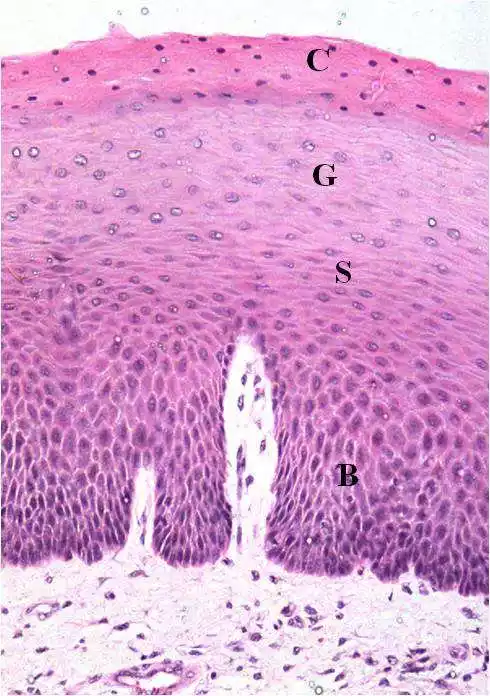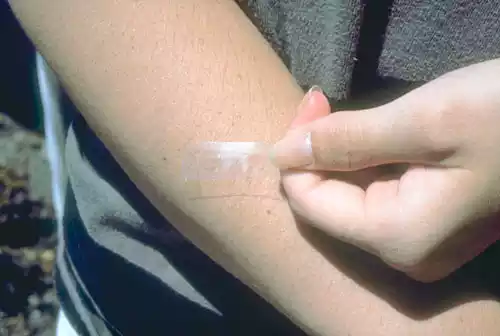Stratum Basale and Stratum Corneum: The skin comprises intricate layers that contribute to its health and function. Two essential layers are the stratum basale and the stratum corneum. The stratum basale, situated at the base of the epidermis, regenerates skin cells and houses keratinocytes and melanocytes. On the other hand, the stratum corneum forms the outermost layer, serving as a protective barrier against external factors. These layers play a vital role in maintaining skin integrity and safeguarding the body.
Definition of Stratum Basale

The stratum basale, also known as the basal cell layer or germinative layer, is the bottommost layer of the epidermis, the outermost layer of the skin. It is responsible for the continuous regeneration of the epidermis and contains actively dividing cells like keratinocytes and melanocytes. These cells play a crucial role in the growth and renewal of the skin, contributing to its overall health and function.
Structure and Functions of Stratum Basale
The stratum basale, situated at the base of the epidermis, is a crucial layer of the skin with distinct structure and functions. It houses actively dividing cells, primarily keratinocytes and melanocytes. These cells serve several key functions:
- Epidermal Regeneration: The stratum basale is responsible for the continuous renewal of the epidermis. New cells are constantly produced in this layer to replace older, worn-out cells that are shed from the skin’s surface.
- Keratinocytes and Melanocytes: Keratinocytes are the predominant cells found in the stratum basale. They play a vital role in producing keratin, a protein that contributes to the strength and waterproofing of the skin. Melanocytes, which also reside in this layer, produce melanin, the pigment responsible for skin color and protection against UV radiation.
- Cell Adhesion and Proliferation: The stratum basale features specialized structures that facilitate cell adhesion. This cohesion ensures that newly formed skin cells remain tightly connected as they move upwards through the epidermal layers. Additionally, the layer’s high rate of cell proliferation contributes to the ongoing renewal of the epidermis.
The stratum basale’s dynamic activities are essential for maintaining the health, function, and integrity of the skin.
Definition of Stratum Corneum

The stratum corneum is the outermost layer of the epidermis, which is the top layer of the skin. It consists of multiple layers of flattened, dead skin cells known as corneocytes. This layer forms a protective barrier that helps prevent excessive water loss, shields the skin from external factors like microbes and pollutants, and contributes to maintaining skin integrity. The stratum corneum plays a vital role in preserving overall skin health and function.
Characteristics and Roles of Stratum Corneum
The stratum corneum, located at the outermost layer of the epidermis, possesses distinct characteristics and plays crucial roles in ensuring skin health and protection. Here are its key characteristics and roles:
- Barrier Function: The primary role of the stratum corneum is to serve as a barrier between the internal body environment and the external world. It acts as a protective shield that prevents excessive water loss from the body and shields the skin from harmful substances, microbes, and environmental stressors.
- Cornified Envelope: The stratum corneum is characterized by a specialized structure known as the cornified envelope. This envelope consists of lipids and proteins that provide structural integrity to the skin’s surface, helping maintain cohesion and resistance to external pressures.
- Hydration and Desquamation: The stratum corneum also plays a crucial role in regulating hydration levels within the skin. It prevents the loss of water from the body while allowing controlled amounts of water to evaporate, contributing to optimal hydration balance. Additionally, the process of desquamation involves the shedding of dead skin cells from the surface of the stratum corneum, allowing for continuous renewal and regeneration of the skin.
By maintaining a robust barrier, preserving hydration, and facilitating controlled shedding, the stratum corneum ensures that the skin remains resilient, adaptable, and well-protected against various environmental challenges.
Importance of Maintaining Healthy Stratum Basale and Stratum Corneum
Maintaining the health of the stratum basale and stratum corneum is paramount for overall skin well-being and optimal bodily function. Here’s why these layers require special attention:
1. Skin Regeneration: A healthy stratum basale ensures the continuous regeneration of the epidermis. This renewal process helps heal wounds, scars, and minor injuries, maintaining the skin’s ability to recover and repair itself.
2. Protection Against Harmful Factors: The stratum corneum serves as the body’s first line of defense against external threats such as microbes, pollutants, and harmful UV radiation. A well-maintained stratum corneum acts as a strong barrier, preventing these factors from penetrating into deeper skin layers.
3. Skin Barrier Function: The stratum corneum’s barrier function prevents excessive water loss from the body, maintaining proper hydration levels. This is essential to prevent skin from becoming dry, flaky, or susceptible to irritation.
4. Overall Skin Health: Healthy stratum basale and stratum corneum layers contribute to vibrant and youthful-looking skin. A well-functioning stratum corneum promotes a smoother texture and appearance by reducing fine lines, wrinkles, and blemishes.
5. Defense Against Infections: The integrity of the stratum corneum acts as a protective shield, preventing harmful microorganisms from entering the body. A compromised barrier could make the skin more susceptible to infections.
6. Thermal Regulation: An intact stratum corneum helps regulate body temperature by preventing excessive water loss through evaporation. This is vital for maintaining internal temperature stability.
7. UV Radiation Protection: The stratum basale’s health is crucial for preventing sunburn and skin damage caused by UV radiation. A well-maintained stratum basale supports the skin’s natural defense mechanisms against harmful sun exposure.
8. Prevention of Skin Disorders: A balanced and healthy stratum corneum can reduce the risk of various skin conditions, including dry skin, eczema, and psoriasis.
Nurturing the stratum basale and stratum corneum through proper skincare, hydration, and protection strategies is essential for achieving and maintaining skin that is not only aesthetically pleasing but also robust in its ability to fend off external challenges and maintain overall health.
Comparison table of Stratum Basale and Stratum Corneum
Here’s a comparison table highlighting the differences between the Stratum Basale and Stratum Corneum:
| Aspect | Stratum Basale | Stratum Corneum |
|---|---|---|
| Location | Bottommost layer of the epidermis | Outermost layer of the epidermis |
| Cell Types | Keratinocytes, Melanocytes | Corneocytes (flattened, dead skin cells) |
| Function | Epidermal regeneration, Cell production | Barrier function, Protection |
| Cell Renewal | Constant cell renewal | Shedding of dead cells, Renewal |
| Specialization | Actively dividing cells, Melanin production | Barrier formation, Cornified envelope |
| Protection | Supports skin growth, Pigmentation | Shields against water loss, External factors |
| Hydration Regulation | Minimal role in hydration regulation | Key role in hydration balance |
| Barrier Integrity | Not the primary barrier layer | Primary protective barrier |
| Interaction with Env. | Limited interaction with external environment | Direct interaction with environment |
This comparison underscores the distinct roles and characteristics of both layers within the skin, emphasizing their importance in maintaining skin health and overall well-being.
Common Skin Issues Related to Stratum Basale and Stratum Corneum
The health of the stratum basale and stratum corneum significantly impacts overall skin well-being. Here are some common skin issues related to these layers:
1. Dry Skin (Xerosis): A compromised stratum corneum can lead to dry skin. Insufficient hydration and a weakened barrier function result in moisture loss, causing the skin to become rough, flaky, and prone to irritation.
2. Sunburn: Prolonged sun exposure damages the stratum basale’s cells, increasing the risk of sunburn. UV radiation penetrates the skin, harming the underlying layers and causing redness, pain, and peeling.
3. Skin Barrier Dysfunction: When the stratum corneum’s barrier is compromised, irritants and allergens can penetrate the skin more easily. This can lead to inflammation, itching, and discomfort.
4. Sensitivity: Imbalance in the stratum corneum’s protective lipid layer can result in increased skin sensitivity. The skin becomes more reactive to external stimuli, causing redness and discomfort.
5. Eczema (Atopic Dermatitis): Genetic and environmental factors can disrupt the stratum corneum’s barrier, leading to conditions like eczema. Itchy, inflamed patches of skin develop, often accompanied by redness and dryness.
6. Psoriasis: Overactivity of the stratum basale’s cell division can lead to psoriasis. This causes the skin to rapidly accumulate, forming thick, silvery scales and red patches.
7. Impaired Healing: If the stratum basale’s regenerative abilities are hindered, wounds may heal slower. This can result in delayed healing and an increased risk of infection.
8. Acne: Acne can originate from imbalances in the stratum basale’s sebum production and clogged pores. This leads to the formation of pimples, blackheads, and whiteheads.
9. Dehydrated Skin: A weakened stratum corneum allows excessive water loss, leading to dehydrated skin. This can cause tightness, dullness, and an overall lack of radiance.
10. Prone to Infections: An impaired stratum corneum barrier can make the skin more susceptible to infections caused by bacteria, fungi, and other microorganisms.
Addressing these issues involves proper skincare, maintaining hydration, protecting the skin from UV radiation, and adopting a healthy lifestyle. By nurturing the health of the stratum basale and stratum corneum, you can effectively prevent and manage various skin concerns, promoting overall skin vitality.
Tips for Nurturing Stratum Basale and Stratum Corneum Health
Here are concise tips for nurturing the health of the stratum basale and stratum corneum:
- Hydrate: Drink water for skin moisture.
- Moisturize: Use suitable moisturizers.
- Sunscreen: Protect from UV rays daily.
- Gentle Cleansing: Avoid harsh cleansers.
- Balanced Diet: Eat nutrient-rich foods.
- Hydrating Ingredients: Look for hyaluronic acid.
- Avoid Hot Water: Use lukewarm water.
- Exfoliate: Gently remove dead skin.
- Humidifier: Maintain indoor moisture.
- Protect Skin: Wear sunscreen and clothing.
- Quit Smoking: It harms skin health.
- Regular Checkups: Visit a dermatologist.
These practices ensure your skin’s vitality and well-being.
Final Thought
Caring for the Stratum Basale and Stratum Corneum is vital for maintaining healthy, vibrant skin. By following proper hydration, protection, and skincare practices, you can enjoy resilient skin that’s well-prepared to face the challenges of daily life.































